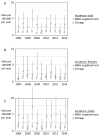Incidence and Prevalence of Achalasia in Central Chicago, 2004-2014, Since the Widespread Use of High-Resolution Manometry
- PMID: 27581064
- PMCID: PMC5316341
- DOI: 10.1016/j.cgh.2016.08.030
Incidence and Prevalence of Achalasia in Central Chicago, 2004-2014, Since the Widespread Use of High-Resolution Manometry
Abstract
Background & aims: Reported global incidence and prevalence values for achalasia vary widely, from 0.03 to 1.63 per 100,000 persons per year and from 1.8 to 12.6 per 100,000 persons per year, respectively. This study aimed to reconcile these low values with findings from a major referral center, in central Chicago (which began using high-resolution manometry in 2004 and used it in all clinical studies since 2005), and has determined the incidence and prevalence of achalasia to be much greater.
Methods: We collected data from the Northwestern Medicine Enterprise Data Warehouse database (tertiary care setting) of adults residing in Chicago with an encounter diagnosis of achalasia from 2004 through 2014. Patient files were reviewed to confirm diagnosis and residential address. US Census Bureau population data were used as the population denominator. We assumed that we encountered every incident case in the city to calculate incidence and prevalence estimates. Data were analyzed for the city at large and for the 13 zip codes surrounding the Northwestern Memorial Hospital (NMH), the NMH neighborhood.
Results: We identified 379 cases (50.9% female) that met the full inclusion criteria; of these, 246 were incident cases. Among these, 132 patients resided in the NMH neighborhood, 89 of which were incident cases. Estimated yearly incidences were stable over the study period, ranging from 0.77 to 1.35 per 100,000 citywide (average, 1.07 per 100,000) and from 1.41 to 4.60 per 100,000 in the NMH neighborhood (average, 2.92 per 100,000). The corresponding prevalence values increased progressively, from 4.68 to 14.42 per 100,000 citywide and from 15.64 to 32.58 per 100,000 in the NMH neighborhood.
Conclusions: The incidence and prevalence of achalasia in central Chicago diagnosed using state-of-the-art technology and diagnostic criteria are at least 2- to 3-fold greater than previous estimates. Additional studies are needed to determine the generalizability of these data to other regions.
Keywords: Achalasia; Epidemiology; Incidence; Prevalence.
Copyright © 2017 AGA Institute. Published by Elsevier Inc. All rights reserved.
Conflict of interest statement
Figures




Comment in
-
Revisiting Epidemiologic Features of Achalasia.Clin Gastroenterol Hepatol. 2017 Mar;15(3):374-375. doi: 10.1016/j.cgh.2016.11.002. Epub 2016 Nov 5. Clin Gastroenterol Hepatol. 2017. PMID: 27826030 No abstract available.
References
-
- Stein CM, Gelfand M, Taylor HG. Achalasia in Zimbabwean blacks. S Afr Med J. 1985;67:261–2. - PubMed
-
- Ho KY, Tay HH, Kang JY. A prospective study of the clinical features, manometric findings, incidence and prevalence of achalasia in Singapore. J Gastroenterol Hepatol. 1999;14:791–5. - PubMed
-
- Birgisson S, Richter JE. Achalasia in Iceland, 1952–2002: an epidemiologic study. Dig Dis Sci. 2007;52:1855–60. - PubMed
-
- Earlam RJ, Ellis FH, Jr, Nobrega FT. Achalasia of the esophagus in a small urban community. Mayo Clin Proc. 1969;44:478–83. - PubMed
-
- Galen EA, Switz DM, Zfass AM. Achalasia: incidence and treatment in Virginia. Va Med. 1982;109:183–6. - PubMed
Publication types
MeSH terms
Grants and funding
LinkOut - more resources
Full Text Sources
Other Literature Sources
Medical
Miscellaneous

